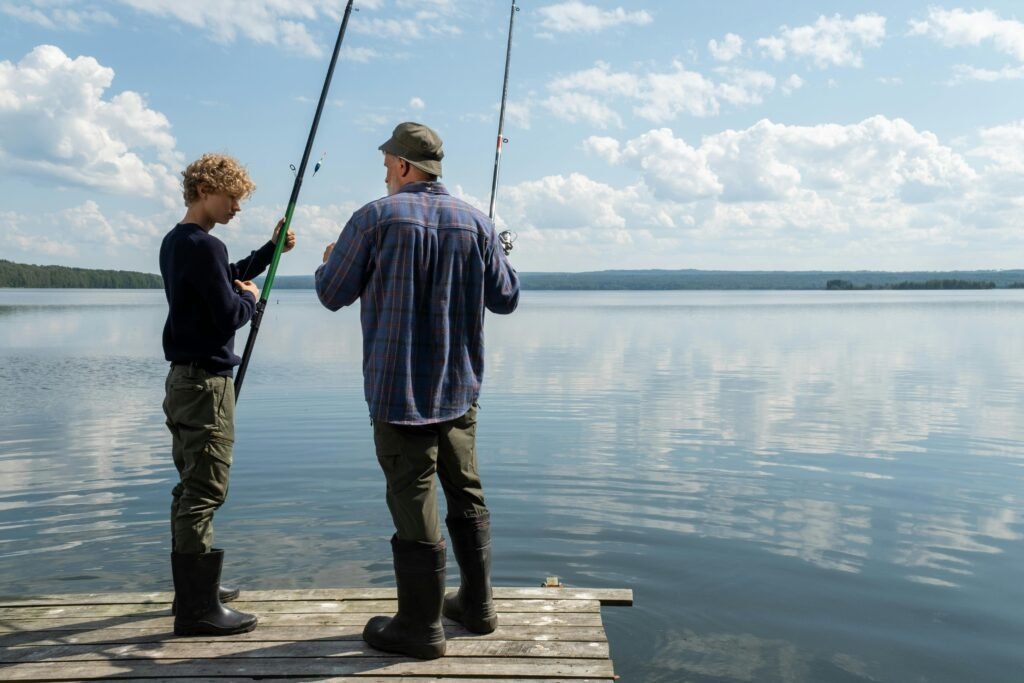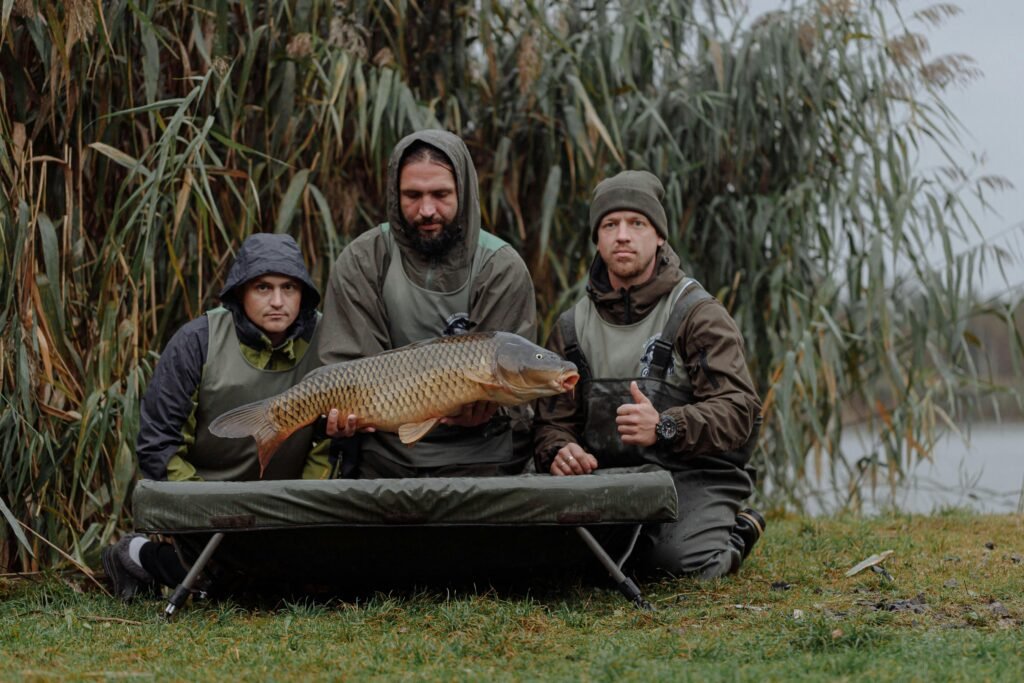Fish Care
Fishing is more than just the thrill of the catch — it’s also about respect for the fish and the waters we all enjoy. Practicing good fish care helps protect fish populations, ensures healthier ecosystems, and makes fishing better for future generations. Whether you plan to release your catch or keep it, handling fish properly reduces stress, increases survival rates, and preserves the quality of the fishery. Taking a few extra moments to care for your catch shows true sportsmanship and helps maintain the balance between recreation and conservation. Every fish matters, and small actions make a big difference.

Catch and Release Best Practices
Use barbless hooks whenever possible:
Barbless hooks cause less damage and make it easier to remove the hook, reducing handling time and injury to the fish. Many anglers pinch down the barbs on their regular hooks with pliers.
Wet your hands before handling fish:
Dry hands can remove the protective slime coating on a fish’s body, making them more vulnerable to disease and infection. Always wet your hands before touching or unhooking a fish.
Keep fish in the water as much as possible:
Minimizing air exposure greatly increases a fish’s chances of survival after release. Try to unhook the fish without ever removing it from the water, especially with delicate species like trout.
Support the fish horizontally — avoid vertical holds:
Always support a fish with one hand under the belly and one at the tail. Avoid holding fish vertically by the jaw (especially large species like bass), which can damage internal organs and cause injury.
Use proper release techniques (revive fish if needed):
If a fish seems tired, gently hold it facing into the current or move it back and forth to pass water over its gills until it swims away under its own power. Never simply toss a fish back into the water.
Handling Fish for Photos

Quick photo tips without stressing the fish:
Prepare your camera and have everything ready before lifting the fish out of the water. Quick action reduces the fish’s stress level.
Keep the fish close to the water:
If the fish flops out of your hands, it’s less likely to be injured if it’s only a few inches above the water. Crouch down or kneel if possible for a safer release.
Avoid squeezing too hard:
A firm but gentle grip is key. Squeezing can damage internal organs or cause bleeding. Hold just enough to prevent slipping without crushing the fish.
Return fish within 30 seconds if possible:
Studies show that the less time a fish spends out of the water, the higher its survival rate. Aim to snap your photo and return the fish within 30 seconds to maximize its chance of recovery.
Fish Transportation and Storage (For Kept Fish)
Humanely kill your fish immediately after capture:
If you plan to keep a fish for eating, it’s important to kill it quickly and humanely to minimize suffering and preserve meat quality. The two most common methods are:
• A sharp blow to the head: Using a fish bat (priest) or a heavy stick, deliver a quick, firm strike just above the eyes. This method instantly stuns and kills the fish.
• Brain spiking (ikejime method): Insert a sharp spike directly into the brain for a near-instant death. This method is used by professional anglers and helps improve the flavor and shelf-life of the fish.
Immediately place fish on ice or in a livewell:
Freshly caught fish spoil quickly if not cooled. After humanely dispatching your fish, place it directly on ice or into a properly aerated livewell to maintain freshness and prevent bacterial growth.
Avoid keeping fish in hot, stagnant water:
If using a stringer or livewell, avoid letting fish linger in warm, low-oxygen water, especially on hot days. Poor conditions can cause unnecessary stress, spoil the meat, and affect flavor.
Bleed larger fish properly to maintain meat quality:
For bigger fish like salmon, tuna, or large freshwater species, bleeding the fish immediately after killing helps remove excess blood from the muscles. To do this, make a small cut behind the gills or sever the arteries near the tail. Allow the fish to bleed out thoroughly on ice or in clean water for the best-tasting fillets.
Conservation and Ethics
Use barbless hooks whenever possible:
Barbless hooks cause less damage and make it easier to remove the hook, reducing handling time and injury to the fish. Many anglers pinch down the barbs on their regular hooks with pliers.
Wet your hands before handling fish:
Dry hands can remove the protective slime coating on a fish’s body, making them more vulnerable to disease and infection. Always wet your hands before touching or unhooking a fish.
Keep fish in the water as much as possible:
Minimizing air exposure greatly increases a fish’s chances of survival after release. Try to unhook the fish without ever removing it from the water, especially with delicate species like trout.
Support the fish horizontally — avoid vertical holds:
Always support a fish with one hand under the belly and one at the tail. Avoid holding fish vertically by the jaw (especially large species like bass), which can damage internal organs and cause injury.
Use proper release techniques (revive fish if needed):
If a fish seems tired, gently hold it facing into the current or move it back and forth to pass water over its gills until it swims away under its own power. Never simply toss a fish back into the water.
FAQ
How do you keep fish good while fishing?
To keep fish in good condition while fishing, it’s important to handle them gently to avoid causing stress or injury. Keep the fish in the water as much as possible to minimize air exposure. If you’re planning to release them, use wet hands or a rubber net to handle them. If you’re keeping fish for consumption, place them in a cooler with ice immediately after catching them to maintain freshness and prevent spoilage.
How to care for a fish for beginners?
For beginners, caring for a fish involves providing the proper environment and nourishment. Make sure the fish have clean, well-oxygenated water, a balanced diet, and a suitable tank or habitat with adequate space. Regularly monitor water temperature, pH levels, and ammonia levels to ensure a healthy environment. It’s also essential to avoid overcrowding and provide fish with hiding spots to reduce stress.
How do you clean fish when fishing?
To clean fish, start by making a clean cut just behind the gills, and then remove the head. Next, make a slit along the belly of the fish and carefully remove the internal organs. Use a knife to scrape off the scales, working from tail to head. Rinse the fish under cold water to clean out any remaining blood and internal residue. Finally, remove the fins and tail if necessary, and the fish is ready for cooking or storage.
What should you not do while fishing?
While fishing, avoid overcrowding your tackle box with unnecessary equipment, as this can make it harder to find what you need. Do not handle fish with dry hands, as it can damage their protective slime coating. Avoid leaving trash behind on the shore or in the water to preserve the environment. Also, be mindful of local fishing regulations regarding catch limits and protected species.
What is the golden rule of fishing?
The golden rule of fishing is to “fish responsibly and sustainably.” This means following local regulations, respecting catch limits, practicing catch-and-release when necessary, and minimizing your environmental impact. Always ensure that fish populations are not overexploited and that you respect the ecosystems you fish in.
What does a beginner fisherman need?
A beginner fisherman needs the following essentials: a fishing rod and reel, suitable fishing line, hooks, and bait or lures. It’s also helpful to have a tackle box for storing these tools, a fishing license (where required), a hat, sunscreen, and a cooler for keeping your catch fresh. Depending on your location, additional gear like a fishing net, pliers, or a fish finder might be beneficial.
